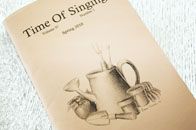© 2015 Lora Homan Zill
 An intuitive “feel” for the music in language makes us human. The sounds of words form the background hum of our lives and can also stick out as attention-getters. Marketers know this when crafting headlines, such as the travel agency declaration, “Sizzlin’ Western Tours: Corral A Wild Deal.” Hear the repeating consonants? They grab your ear by connecting the words through sound.
An intuitive “feel” for the music in language makes us human. The sounds of words form the background hum of our lives and can also stick out as attention-getters. Marketers know this when crafting headlines, such as the travel agency declaration, “Sizzlin’ Western Tours: Corral A Wild Deal.” Hear the repeating consonants? They grab your ear by connecting the words through sound.
But marketers aren’t the only ones who tap into this music. When you named your children, you probably voiced different combinations of first, middle, and last names until you hit upon the sound that felt right to you.
Poets can use that intuitive sense for sound when they write poetry. We all know the popular rhymes in greeting cards. That pleasant music is familiar and emotionally appealing. But there are many other ways to add it to your poems.
Write fresh rhyme, not trite combinations like in greeting cards (very effective for their purpose) such as the overused God/sod or cross/loss. They might seem new to the poet, but their use will guarantee a rejection from my desk.
So what you can do to add music to your poetry in creative ways?
You can use an “almost” rhyme (sometimes called a “slant rhyme”) for some creative sounds, e.g. in my poem “November”:
a sweeter breath in early-shadowed days.
The line-ending words “taste” and “days” aren’t an exact rhyme, but the repeating “s” and long “a” sounds tie that couplet together quite nicely.
Another way to add sound is to repeat consonants and vowels. Note the repeating “n” in the first line that brings to mind a sound from nature—the hum of the wind. The other repeating sounds in both lines (“d” and “s”) weave them together as well. Your reader might not be explicitly aware of your technique but will intuit the music in your language and gain pleasure from the poem.
You can also use internal rhyme by placing your rhyming words in the line, not on the end. The reader receives a nice surprise, like finding an unexpected treasure in a gift shop.
Creativity in sound is one tool in the poet’s tool box that’s often overlooked. That’s too bad, because our intuitive feel for the sound in language adds pleasure to our writing craft. I encourage you to try it.
____________________
Lora Homan Zill is a Teaching Artist with the Pennsylvania Council on the Arts and publishes the Christian literary poetry magazine, Time Of Singing. She teaches composition at Gannon University and creative writing and poetry to gifted students. A conference speaker, she also leads Blue Wind Retreats for Christians in creative expression. Her award winning poetry and prose have been published widely. Lora blogs about feeling God’s pleasure in creative work at The Blue Collar Artist.

